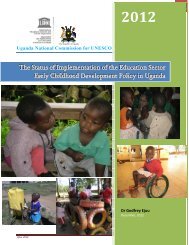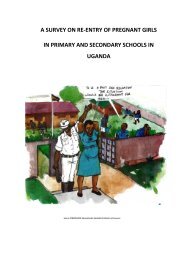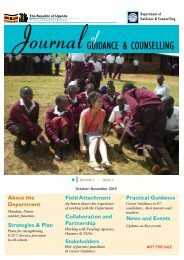Download Pdf - Ministry of Education and Sports
Download Pdf - Ministry of Education and Sports
Download Pdf - Ministry of Education and Sports
Create successful ePaper yourself
Turn your PDF publications into a flip-book with our unique Google optimized e-Paper software.
101<br />
(i)<br />
(ii)<br />
(iii)<br />
(iv)<br />
(v)<br />
(vi)<br />
Goal 1: Exp<strong>and</strong>ing <strong>and</strong> improving comprehensive Early Childhood Care <strong>and</strong> <strong>Education</strong>,<br />
especially for most vulnerable <strong>and</strong> disadvantaged children;<br />
Goal 2: Ensuring that by 2015 all children, particularly girls, children in difficult circumstances<br />
<strong>and</strong> those belonging to ethnic minorities, have access to, <strong>and</strong> complete, free <strong>and</strong> compulsory<br />
Primary <strong>Education</strong> <strong>of</strong> good quality;<br />
Goal 3: Ensuring that the learning needs <strong>of</strong> all young people <strong>and</strong> adults are met through<br />
equitable access to appropriate learning <strong>and</strong> life – skills programs;<br />
Goal 4: Achieving a 50% improvement in levels <strong>of</strong> adult literacy by 2015, especially for<br />
women, <strong>and</strong> equitable access to basic <strong>and</strong> continuing education for all adults;<br />
Goal 5: Eliminating gender disparities in Primary <strong>and</strong> Secondary <strong>Education</strong> by 2005, <strong>and</strong><br />
achieving gender equality in education by 2015, with a focus on ensuring girls’ full <strong>and</strong> equal<br />
access to <strong>and</strong> achievement in basic education <strong>of</strong> good quality; <strong>and</strong>,<br />
Goal 6: Improving all aspects <strong>of</strong> the quality <strong>of</strong> education <strong>and</strong> ensuring excellence <strong>of</strong> all so that<br />
recognized <strong>and</strong> measureable learning outcomes are achieved by all, especially in literacy,<br />
numeracy <strong>and</strong> essential life skills.<br />
Over the years (20002012), Ug<strong>and</strong>a has registered a number <strong>of</strong> milestones in the education sector<br />
pertaining to the EFA Goals. This report therefore, provides a quantitative measure <strong>of</strong> the extent to<br />
which Ug<strong>and</strong>a is meeting the Dakar commitments (the six EFA goals) given the fact that only three<br />
<strong>and</strong> half years are remaining to mark the end <strong>of</strong> the current EFA programme.<br />
4.5.1 EFA Goal 1: Early Childhood Care & <strong>Education</strong> (ECCE)<br />
The World Declaration on EFA in Jomtien (1990) introduced the idea that “learning begins at birth”<br />
affirming ECCE as an integral part <strong>of</strong> basic education <strong>and</strong> an educational level in its own right. The<br />
target for goal 1 is to ensure exp<strong>and</strong>ed <strong>and</strong> improved comprehensive Early Childhood Care <strong>and</strong><br />
<strong>Education</strong>, especially for the most vulnerable <strong>and</strong> disadvantaged children. Since 2000, the education<br />
<strong>and</strong> sports sector has been tracking progress made towards the attainment <strong>of</strong> this goal using three<br />
indicators (i.e preschool enrolment, Gross Enrolment Ratio <strong>and</strong> Net enrolment Ratio).<br />
4.5.1.1 Pre‐school enrolment<br />
Officially, in Ug<strong>and</strong>a children aged 35 years are expected to be enrolled in preschool such that by the<br />
age <strong>of</strong> six they proceed to primary one. Over the years, there has been a wide gap between the preschool<br />
enrolment <strong>and</strong> the population aged 35 years. Majority <strong>of</strong> children aged 3‐5 in Ug<strong>and</strong>a do not<br />
access preschool educational opportunities despite growing access over the years. In 2001/2002, only<br />
59,829 (male 29,589; female 253,039) pupils were enrolled in the preprimary subsector <strong>and</strong> by 2009/10<br />
the enrolment had multiplied by seven times. In FY 2011/12, the enrolment increased to the turn <strong>of</strong><br />
345,295 (male 170,245; female 175,050). The increase in enrolment is mainly attributed to government<br />
efforts in advocating for early childhood development over the last four years.<br />
4.5.1.2 Pre‐primary Net Enrolment Rate<br />
NER reveals the preschool enrolment gap with respect to age. If all children aged 35 years are<br />
enrolled in preschool, the NER will be 100 percent. Figure 4.33 below shows trends <strong>of</strong> Net Enrolment<br />
rate in preprimary in Ug<strong>and</strong>a;<br />
ESSAPR FY 2011/12 to inform the 19 th ESSR – OCTOBER 2012








